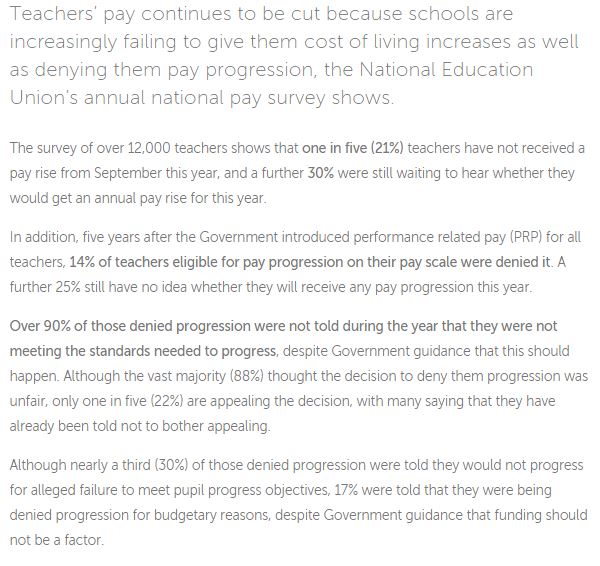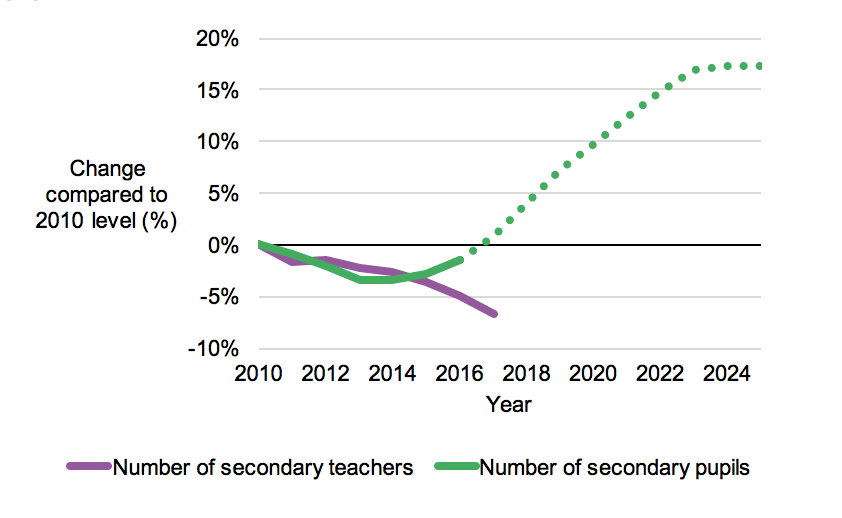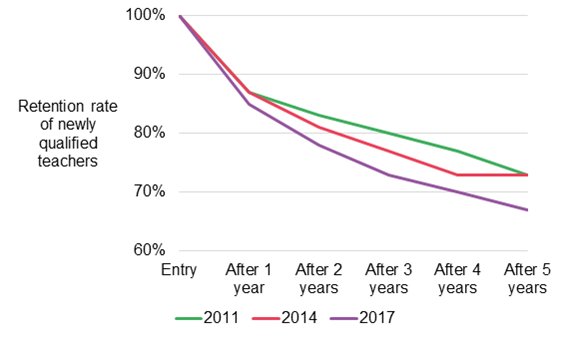One of my own criticisms of our profession is our ability to share bad news over good. Even when the DfE shares good news, we have a tendency to mark it with red pen and share the faults. That said, three topics, all inter-connected, should be challenged, highlighted and tackled head on. Funding, Performance Review (particularly when linked to performance pay), both inexplicably linked to the find point, the retention and recruitment of teachers and potential teachers (here I include the notable and excellent contribution by Teaching Assistants and the development of Teaching Assistants to teachers).
This is not a post or rant about funding, funding can be summed up by @vicgoddard’s mid week reflection and the intensity of conversation centred around that viewpoint. Though funding can not be detached either.
Nor is it a rant about the toxicity of performance review. I consistently, unsuccessfully, challenge the DfE and Ofsted to share with the profession evidence to support for Performance Related Pay (PRP). I will do so again now, furthermore, I commit to contacting both bodies again, after publishing this post and I forecast, that it will achieve little more than an acknowledgement, though no evidence.
I am so disappointed with, and concerned for, the outlook of the teaching professions that I have offered some of my professional time to the Education Support Partnership, the UK’s only charity providing mental health and wellbeing support services to all education staff and organisations. To support staff wilting under poorly constructed and deployed system change and the toxic influence of inaccurate and biased performance review and PRP frameworks.

Which then draws me to the excellent commentary of Jack Worth – education economist @TheNFER. Jack is currently the School Workforce Lead: researching how to improve teacher recruitment, retention and development. Using his Tweets and NFER reports I have written a short summary for Head Teachers to share with their governing bodies and Trustee in their final annual meetings, to give our governance boards the opportunity to reflect well in advance of the October annual pay review fo teachers and before the STRB report is shared.
Why should ‘we’ be concerned? (Secondary)
Simple maths – the average pupil-teacher ratio has increased from 14.9 in 2011 to 16.0 in 2017. That figure will rise steeply unless we retain, develop and support teachers, manage the system within which they work and attract the brightest to the profession. Here is my over-simplified summary and what I will be sharing with our Trustee Board at our next meeting.
The outlook
The pupil number swell that has been going through primary schools since 2010, is due to hit secondaries. Over the next decade, we are expecting a 19% increase in pupil numbers at a time when teacher recruitment is not growing fast enough, and attrition rates are falling steeply.

Below target teacher recruitment (for the last five consecutive years) and rising attrition can be seen at both ends of the teacher workforce. Fewer teachers are making it through a full career, (10.4% of secondary teachers left in 2017, compared to 9.4% in 2011), fewer early career teachers are being retained, more teachers are leaving the profession thereafter and more are retiring early. According Ann Mroz, early retirement alone, accounts for a loss of 4,000 teachers annually.* (Just checking that figure).

Falling retention when comparing 2011 and 2017: One-year (87% to 85%), three-year (80% to 73%) and five-year retention rates (80% to 73%).
Having invested £20,000 to train a teacher, plus potentially hefty bursaries to attract them, that hardly makes good business sense. Not forgetting the on-boarding investment of the school itself circa 15-20k per employee.
This is of particular concern for my personal professional context, where we are moving to recruit experienced teachers over newly qualified teachers.
The proportion of teachers considering leaving has, however, increased significantly in the last year from 17 to 23 per cent. While smaller proportions than this actually leave, this figure has also increased. Let’s not forget, that British teachers are highly sought after overseas.
This is a broad overview and is hugely concerning, obscuring subject and geographical variance. What we do know, is that
This situation represents a serious threat to educational standards, particularly in schools in areas of high disadvantage where it is often most difficult to recruit teachers. – Geoff Barton General Secretary, the Association of School & College Leaders
School Teachers’ Review Body
If you are interested in this topic and head over to the STRB there really is minimal information.There is the former minister’s letter from December 7th. A letter that states that the minister will provide a detailed account of
the teacher labour market based on the latest recruitment and retention data. I will also provide evidence on affordability and value for money.
This Government evidence can be found here. Though not that easy to locate.
On teacher recruitment the evidence says
37. At a national level, we are recruiting the teachers we need. However, we recognise that teacher recruitment has been a challenge, particularly in some subjects and for some schools, not least in the context of an improving economy and a strengthening graduate labour market
On teacher retention, the evidence says
44. Official statistics show that after gaining QTS and starting teaching, around 70% of teachers teach in state-funded schools for at least five years; 60% for at least ten years; 50% teach for at least 20 years. These retention rates have been broadly similar for the last 20 years, as can be seen in table 8 in Annex B, which shows retention rates by year of QTS.
That tone seems remarkably at odds with that of the NFER reports.
One final point
49. The fundamental changes to teachers’ pay that have been introduced over the last four years following the STRB’s recommendations have given greater autonomy to schools to decide how to reward their staff.
Yet, here again, evidence seems quite contradictory, that schools have changed very little?
The STRB report was due “early May 2018.” Here we are in July? The STRB will not have had time to consider Jack Worth’s excellent summary, let’s hope someone delivers it to them.


